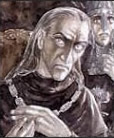Commentary on “The Last Ship”
Note: the commentary follows the poem
The Last Ship
Firiel looked out at three o’clock:
the grey night was going;
far away a golden_cock
clear and shrill was crowing.
The trees were dark, and the dawn pale,
waking birds were cheeping,
a wind moved cool and frail
through dim leaves creeping.
She watched the gleam at window grow,
till the long light was shimmering
on land and leaf; on grass below
grey dew was glimmering.
Over the floor her white feet crept,
down the stair they twinkled,
through the grass they dancing stepped
all with dew besprinkled.
Her gown had jewels upon its hem,
as she ran down to the river,
and leaned upon a willow-stem,
and watched the water quiver.
A kingfisher plunged down like a stone
in a blue flash falling,
bending reeds were softly blown,
lily-leaves were sprawling.
A sudden music to her came,
as she stood there gleaming
with fair hair in the morning’s flame
on her shoulders streaming.
Flutes were there, and harps were wrung,
and there was sound of singing,
like wind-voices keen and young
and far bells ringing.
A ship with golden beak and oar
and timbers white came gliding;
swans went sailing on before,
her tall prow guiding.
Fair folk out of Elvenland
in silver-grey were rowing,
and three with crowns she saw there stand
with bright hair flowing.
With harp in hand they sang their song
to the slow oars swinging;
‘Green is the land the leaves are long,
and the birds are singing.
Many a day with dawn of gold
this earth will lighten,
many a flower will yet unfold,
ere the cornfields whiten.
‘Then whither go ye, boatmen fair,
down the river gliding?
To twilight and to secret lair
in the great forest hiding?
To Northern isles and shores of stone
on strong swans flying,
by cold waves to dwell alone
with the white gulls crying?’
‘Nay!’ they answered. ‘Far away
on the last road faring,
leaving western havens grey,
the seas of shadow daring,
we go back to Elvenhome,
where the White Tree is growing,
and the Star shines upon the foam
on the last shore flowing.
‘To mortal fields say farewell,
Middle-earth forsaking!
In Elvenhome a clear bell
in the high tower is shaking.
Here grass fades and leaves fall,
and sun and moon wither,
and we have heard the far call
that bids us journey thither’.
The oars were stayed. They turned aside:
‘Do you hear the call, Earth-maiden?
Firiel! Firiel!’ they cried,
‘Our ship is not full-laden.
One more only we may bear.
Come! For your days are speeding.
Come! Earth-maiden elven-fair,
our last call heeding.’
Firiel looked from the river-bank,
one step daring;
then deep in clay her feet sank,
and she halted staring.
Slowly the elven-ship went by
whispering through the water;
‘I cannot come!’ they heard her cry.
‘I was born Earth’s daughter!’
No jewels bright her gown bore,
as she walked back from the meadow
under roof and dark door,
under the house-shadow.
She donned her smock of russet brown,
her long hair braided,
and to her work came stepping down.
Soon the sunlight faded.
Year still after year flows
down the Seven Rivers;
cloud passes, sunlight glows,
reed and willow quivers
at morn and eve, but never more
westward ships have waded
in mortal waters as before,
and their song has faded.
~~~~~~~~~~~~~~~~~~~
The story of Fíriel in “The Last Ship” strikes a tender chord in many readers. But why does it affect us so deeply? Why is it that when we read a story like Fíriel’s(who gave up the chance for immortality), or Arwen’s (who gave up her own immortality), we find ourselves so moved?
The answer lies in our own personal desire for immortality. All of us, at some level or other, desire it. We wish to be famous, to have a good life, to leave a good name, at the very least, to be healty and to live as long as we can. Why do we have this desire to be immortal?
Perhaps it’s the fear of death. We are comfortable with the world around us and, as brave as we may be about life, we still feel a tinge of fear thinking about the greatest unknown there is: the thing that Tolkien considered both the curse and blessing of mankind, death. Even the Elves seem, to some extent, to fear it, many of them choosing to sail away to the Undying Lands when faced with Sauron’s darkness (full of death!) possibly spreading over Middle-earth at the end of the Third Age. Thus it’s easy to say that “the choice of Lúthien” would be a cause of much grief, and we can say why Nimrodel and, in this case, Fíriel’s lay is written as a lament.
In Tolkien’s world, it is not only possible for an immortal such as Arwen and Lúthien to become mortal, but also for a mortal like Fíriel to become immortal. Such instances may be rare, but are hinted at in Tolkien’s writings. In Sauron Defeated, Chapter 11, page 125, we find a small epilogue which Tolkien intended to include in LotR, but his publishers thought it too much. In it, Sam discusses with his daughter Elanor what has happened since the War of the Ring:
“And when you’re tired, you will go, Sam-dad. You will go to the Havens with the Elves. Then I shall go with you. I shall not part with you, like Arwen did with Elrond.”
“Maybe, maybe,” said Sam kissing her gently. “And maybe not. The choice of Luthien and Arwen comes to many, Elanorelle, or something like it; and it isn’t wise to choose before the time.”‘
Obviously, in “The Last Ship,” the time had come for Fíriel’s choice, and she chose the path of few elven-kind and remained the Earth Maiden. She looked at the immortality lying across the shining waters, perhaps even hesitated a little, but as the clay on the bank tugged at her feet, she realized that her choice was to remain as she was born, daugher of earth.
So why did Fíriel refuse the call of immortality, when so many of us would probably spring into that Elven-boat, maybe even leaving our shoes stuck fast in the muddy clay. Was it a sence of duty for the tasks still to be done on earth? Was it loyalty to the peoples of the earth? For the text says that “she donned her smock of russet-brown…and to her work came stepping down.” We may never know, until perhaps, one day, that choice is given to us.
by ~wild_shieldmaiden~
~~~~~~~~~~~~~~~~~~~
It’s very natural for a fan of Tolkien’s work to wish they could somehow enter the world he created. The Lord of the Rings touches us in so many ways, we feel a part of that world, even though we can’t live and breathe in it. Fantasy in general tends to treat us the same way. We like it so much, we wish it could be real. This is something Tolkien may have been addressing when he wrote the poem “The Last Ship”. Fíriel, the main character, is touched by an encounter with Elvenland and she feels the draw and beauty of it very poignantly.
The name “Fíriel” means “mortal daughter”. She belongs to the world of her birth, though the world of the Elves calls to her. She wants to follow the summons, but finds that doing so would go against her nature. “I was born Earth’s daughter!” she cries. In the same way, we want to follow the Elves on their journey to Valinor. When Tolkien writes of the passing age in The Return of the King, we don’t want it to end. It’s hard to believe that such a beautiful race could pass on forever. When given the choice to follow, we would eagerly go. Like Fíriel, however, such a choice would go against our nature.
Although Fíriel does not go with the elves, we shouldn’t think her life is somehow doomed to despair. Rather, we should imagine how beautiful life will seem to her, now that she has seen a glimpse of Elvenland. A “smock of russet brown” replaces her “gown with jewels upon its hem”, yet the jewels still shine bright in her heart. Fíriel’s imagination won’t let her mind forget the beauty of the elves. In this way, her eyes will see her work as something noble, fulfilling the lot she decided to keep as daughter of the Earth.
Still, the parting with Elvenland is a sad thing, which is why the poem ends on a sorrowful note. Perhaps Tolkien was mourning the fact that Elvenland has disappeared so thoroughly in this day and age. The beauty which inspired Fíriel has all but vanished from the Earth. So this poem should be an inspiration to us, because we are the ones now responsible for keeping the light of the elves alive. Like Fíriel, we have a task and a duty to fulfill as children of the Earth.
by Fealome








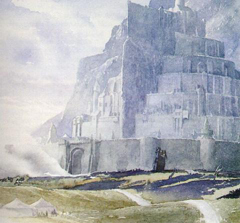 Minas Tirith
Minas Tirith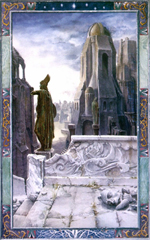 The White Cities
The White Cities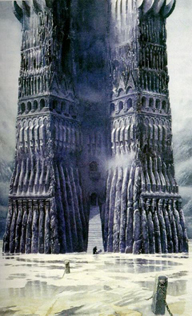 Unbreakable Stone, Unbreakable Wizard
Unbreakable Stone, Unbreakable Wizard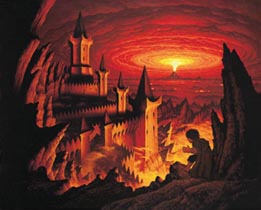 In Mockery of Light
In Mockery of Light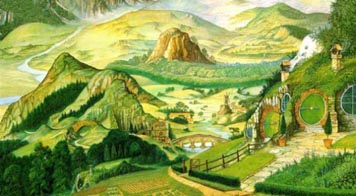 Shelter From the Outside
Shelter From the Outside